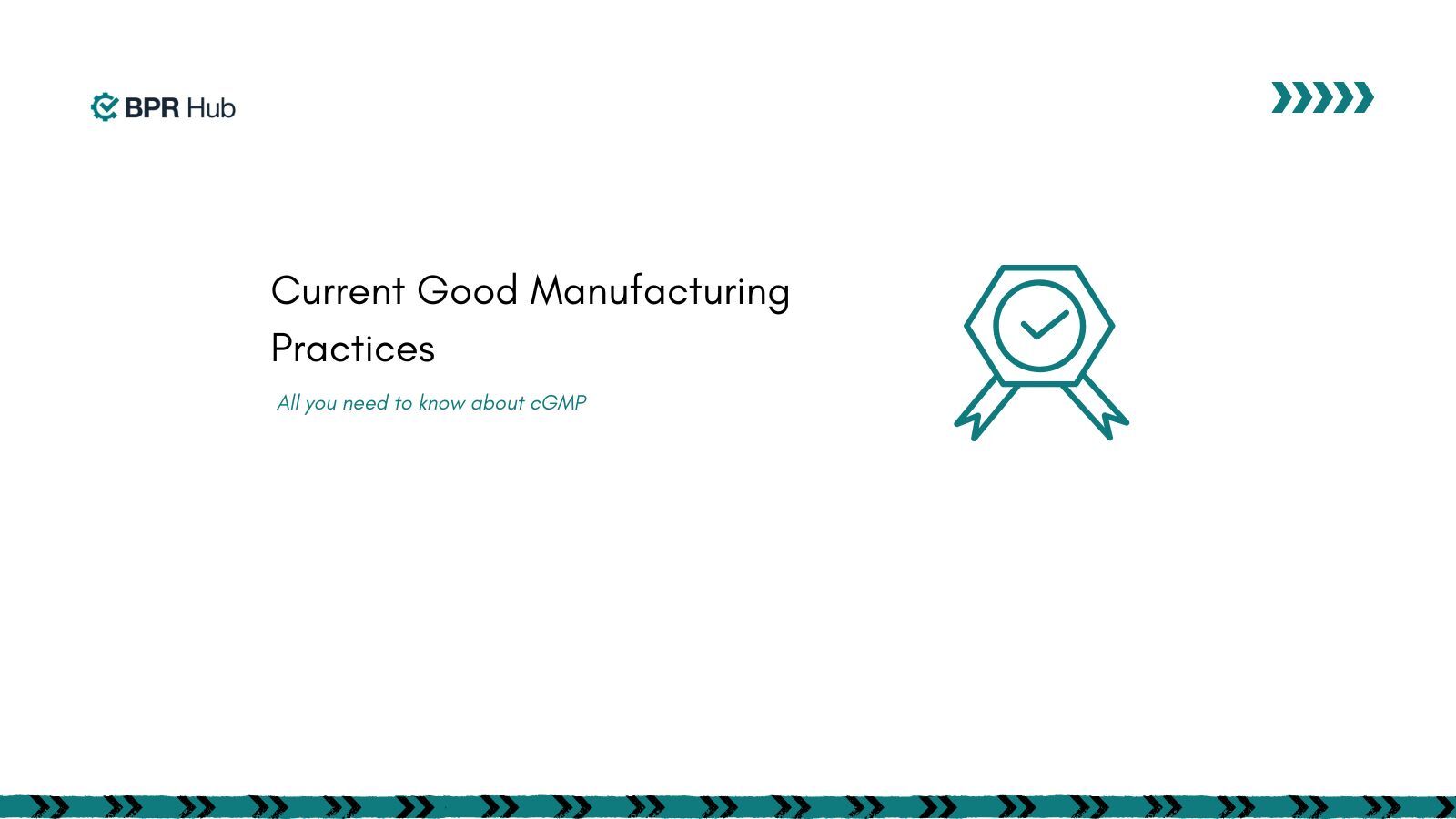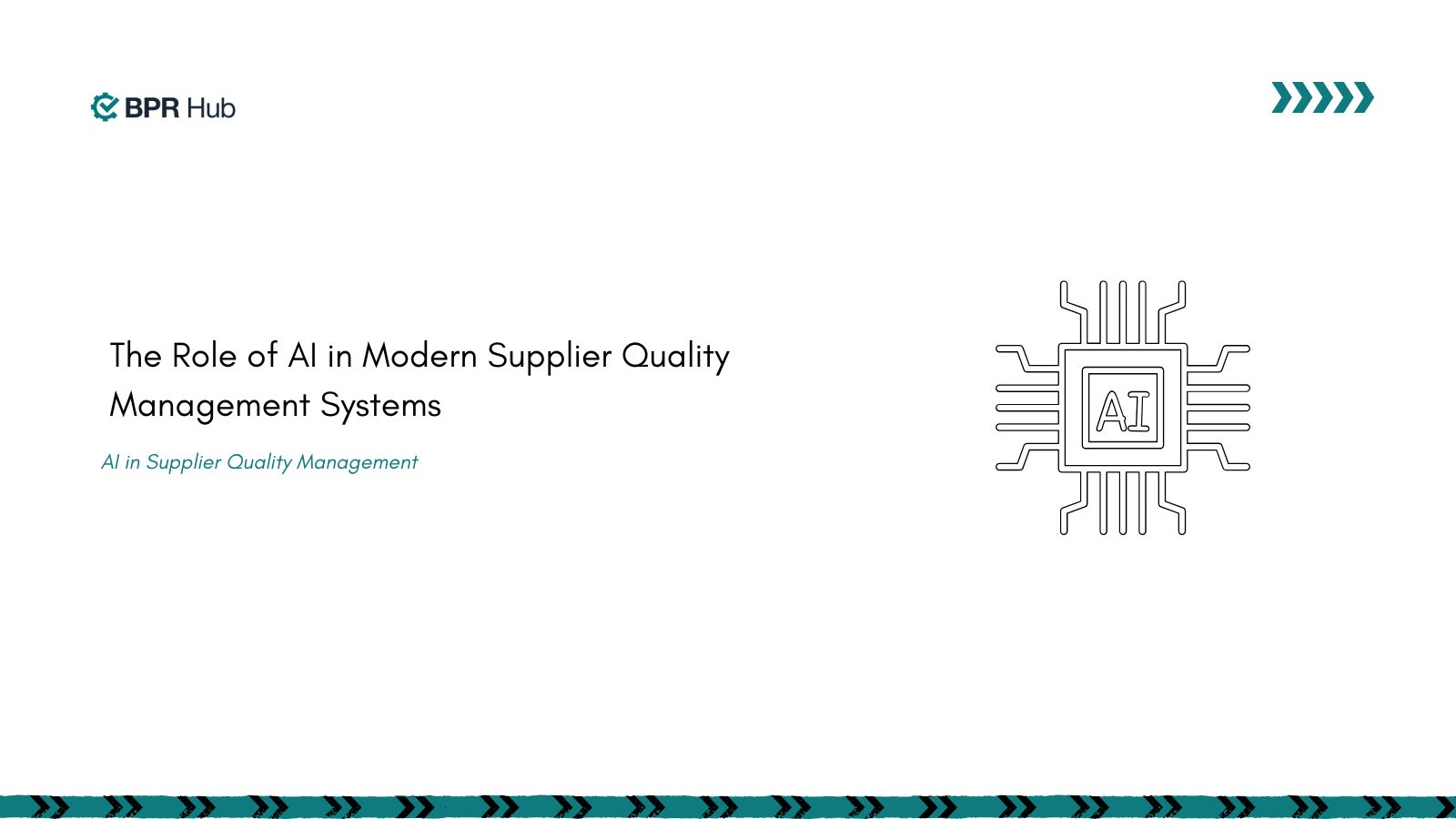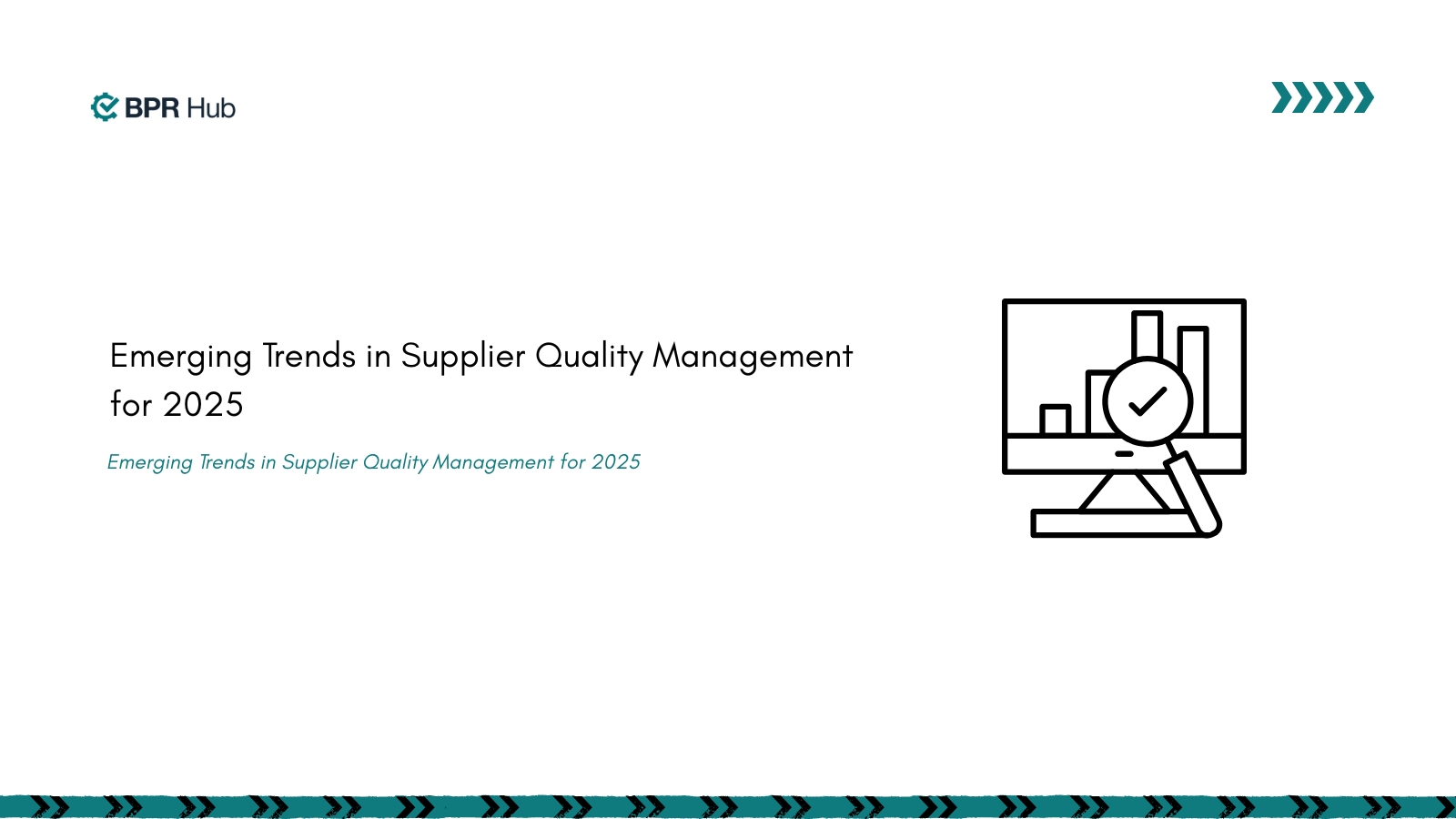Manufacturing operations face increasing pressure to maintain product quality while scaling production efficiently. Current good manufacturing practices serve as the foundation for achieving both objectives simultaneously, transforming regulatory compliance from a bottleneck into a competitive advantage.
Current Good Manufacturing Practice Regulations empower manufacturers to streamline operations, reduce risks, and accelerate market entry. Understanding these requirements positions your organization to turn audits into growth milestones rather than stressful interruptions.
What is cGMP?
Current good manufacturing practices represent a comprehensive set of regulations established by the Food and Drug Administration (FDA) to ensure consistent quality and safety in manufacturing processes. These current good manufacturing practices FDA guidelines apply across multiple industries, including pharmaceuticals, food and beverage, medical devices, and dietary supplements.
The term "current" emphasizes the dynamic nature of these standards. Unlike static regulations, Current Good Manufacturing Practice requirements evolve with technological advances and industry best practices, ensuring manufacturers stay aligned with the latest safety and quality benchmarks.
Key Characteristics of cGMP:
- Regulatory framework: Enforced by the FDA with legal implications for non-compliance
- Industry-agnostic: Applicable across pharmaceutical, food, medical device, and supplement manufacturing
- Quality-focused: Emphasizes product consistency, safety, and efficacy
- Process-oriented: Covers the entire manufacturing lifecycle from raw materials to finished products
- Documentation-driven: Requires comprehensive record-keeping and traceability
These standards transform manufacturing operations by establishing clear protocols that protect both consumers and manufacturers. Companies implementing robust current good manufacturing process frameworks experience fewer product recalls, reduced regulatory scrutiny, and enhanced market reputation.
What is the Importance of cGMP?
Current Good Manufacturing Practice Regulations serve as the backbone of modern manufacturing excellence, creating measurable business value beyond regulatory compliance. Organizations that embrace these standards unlock operational efficiencies that directly impact their bottom line.
Business Impact of cGMP Implementation
Risk Mitigation
- Reduces product liability exposure through consistent quality controls
- Minimizes recall risks that can cost millions in direct and indirect damages
- Protects brand reputation through proactive quality management
Operational Excellence
- Streamlines production workflows through standardized procedures
- Improves resource utilization and reduces waste
- Enhances employee productivity through clear role definitions
Market Access
- Enables faster regulatory approvals for new products
- Facilitates entry into international markets with stringent quality requirements
- Builds customer confidence through demonstrated quality commitment
Financial Performance
- Reduces inspection failures and associated remediation costs
- Improves insurance rates through demonstrated risk management
- Increases operational efficiency, leading to improved profit margins
The transformation becomes evident when manufacturers transition from reactive compliance management to proactive quality leadership. Before implementing comprehensive current good manufacturing practices, companies often struggle with inconsistent documentation, unclear responsibilities, and audit preparation stress. With robust cGMP frameworks, these same organizations achieve audit-ready status year-round while maintaining smooth production operations.
What is the Objective of cGMP?
The primary objective of Current Good Manufacturing Practice standards centers on ensuring product quality, safety, and efficacy throughout the entire manufacturing process. These regulations create a systematic approach to quality management that protects consumers while enabling sustainable business growth.
Core Objectives Include
Product Quality Assurance
- Establish consistent manufacturing processes that deliver reliable product outcomes
- Implement quality control measures at every production stage
- Ensure products meet predetermined specifications and safety standards
Consumer Protection
- Prevent contamination and adulteration of manufactured products
- Minimize health risks associated with substandard manufacturing practices
- Maintain product integrity from production through distribution
Regulatory Compliance
- Provide a clear framework for meeting FDA requirements
- Standardize industry practices across different manufacturing sectors
- Enable effective regulatory oversight and inspection processes
Business Sustainability
- Create scalable quality management systems that grow with business expansion
- Build operational resilience through documented procedures and trained personnel
- Establish competitive advantages through superior quality management
These objectives work synergistically to create manufacturing environments where quality becomes a natural outcome rather than an afterthought. Organizations that align their operations with these objectives experience fewer quality issues, smoother audits, and improved customer satisfaction.
Ready to turn compliance into a competitive edge? Schedule a free demo of BPRHub
📍 Book a Demo
📧 hello@bprhub.com
What Is the Difference Between GMP and cGMP?
Understanding the distinction between GMP and cGMP clarifies the evolution of quality standards in modern manufacturing. While both frameworks focus on quality assurance, Current Good Manufacturing Practice represents an enhanced approach that addresses contemporary manufacturing challenges.
Key Differences
Regulatory Evolution
- GMP provides foundational manufacturing standards
- Current good manufacturing practices incorporate modern quality management principles
- cGMP adapts to technological advances and industry innovations
Implementation Complexity
- GMP focuses on basic compliance requirements
- cGMP demands comprehensive quality management systems
- Current Good Manufacturing Practice Regulations require an integrated approach across all operations
Business Impact
- GMP ensures minimum acceptable standards
- cGMP drives continuous improvement and operational excellence
- Current good manufacturing process frameworks enable competitive differentiation
The transition from basic GMP to comprehensive cGMP implementation represents a strategic decision that positions manufacturers for long-term success. Organizations embracing this evolution experience enhanced operational control, improved audit outcomes, and stronger market positioning.
Note:The FDA uses 'current Good Manufacturing Practices' (cGMP) to emphasize that practices must remain current with technological advances, though the terms GMP and cGMP are used interchangeably in official regulations.
What Are the Key cGMP Requirements?
Current Good Manufacturing Practice Regulations encompass comprehensive requirements that address every aspect of manufacturing operations. These requirements create a holistic quality management framework that ensures consistent product quality while maintaining operational efficiency.
Personnel and Training Requirements
Qualified Personnel
- Employ individuals with appropriate education, training, and experience
- Establish clear job descriptions and responsibility matrices
- Implement ongoing competency assessment programs
Training Programs
- Provide comprehensive cGMP training for all manufacturing personnel
- Document training completion and maintain training records
- Conduct regular refresher training to ensure knowledge currency
Hygiene Standards
- Implement personal hygiene protocols to prevent contamination
- Provide appropriate protective equipment for manufacturing environments
- Establish health monitoring programs for personnel handling products
Facility and Equipment Standards
Design Requirements
- Design facilities to prevent contamination and ensure product quality
- Implement appropriate environmental controls for manufacturing areas
- Establish segregation protocols for different product types
Equipment Validation
- Validate all manufacturing equipment for intended use
- Implement preventive maintenance programs
- Establish equipment cleaning and sanitization procedures
Environmental Monitoring
- Monitor critical environmental parameters continuously
- Implement alert and action limits for environmental conditions
- Document environmental monitoring results and corrective actions
Documentation and Record-Keeping
Batch Records
- Maintain complete batch manufacturing records for traceability
- Document all manufacturing steps and quality control results
- Implement electronic or paper-based record systems with appropriate controls
Standard Operating Procedures (SOPs)
- Develop comprehensive SOPs for all manufacturing operations
- Implement document control systems to ensure current versions
- Train personnel on SOP requirements and updates
These requirements work together to create manufacturing environments where quality becomes predictable and controllable. Organizations that master these requirements transform their operations from reactive problem-solving to proactive quality leadership.
What Are the Key Areas of cGMP?
Current good manufacturing practices address six critical areas that collectively ensure comprehensive quality management throughout manufacturing operations. Each area contributes essential elements to the overall quality framework, creating interconnected systems that deliver consistent results.
1. Organization and Personnel
This foundational area establishes the human infrastructure necessary for effective quality management. Proper organization ensures clear accountability while qualified personnel execute quality requirements consistently.
Key Components
- Clear organizational structure with defined roles and responsibilities
- Qualified personnel with appropriate education and training
- Ongoing competency development programs
- Personnel hygiene and health monitoring protocols
Implementation Benefits
Reduces human error through clear procedures and training
Improves operational consistency across different shifts and personnel
Enhances regulatory compliance through documented competencies
2. Buildings and Facilities
Manufacturing facilities serve as the foundation for quality production, requiring careful design and maintenance to prevent contamination and ensure product integrity.
Critical Elements
- Appropriate facility design for intended manufacturing operations
- Environmental controls for temperature, humidity, and air quality
- Segregation of operations to prevent cross-contamination
- Cleaning and maintenance protocols for all facility areas
Business Impact
- Prevents costly product recalls through contamination prevention
- Improves operational efficiency through optimized facility design
- Reduces maintenance costs through proactive facility management
3. Equipment
Manufacturing equipment directly impacts product quality, requiring validation, maintenance, and control to ensure consistent performance throughout production cycles.
Essential Requirements
- Equipment validation for intended manufacturing use
- Preventive maintenance programs with documented schedules
- Calibration programs for critical measurement equipment
- Cleaning validation for equipment used in multiple products
4. Control of Components and Drug Product Containers
Raw materials and packaging components significantly influence final product quality, necessitating comprehensive control systems from receipt through use in manufacturing.
Control Measures
- Incoming inspection and testing of all components
- Quarantine systems to prevent the use of unqualified materials
- Identity verification and strength testing, where applicable
- Storage conditions that maintain component quality
5. Production and Process Controls
Manufacturing processes require systematic control to ensure consistent product quality and compliance with established specifications.
Process Control Elements
- Written procedures for all manufacturing operations
- In-process controls and testing at critical manufacturing steps
- Batch documentation systems for complete traceability
- Investigation procedures for deviations and discrepancies
6. Laboratory Controls
Quality control testing provides objective evidence that products meet established specifications and safety requirements.
Laboratory Requirements
- Testing of raw materials, in-process samples, and finished products
- Method validation for all analytical procedures
- Laboratory equipment qualification and maintenance
- Stability testing programs for product shelf-life determination
These interconnected areas create comprehensive quality management systems that transform manufacturing operations. Organizations that excel in all six areas experience predictable quality outcomes, streamlined audits, and enhanced customer confidence.
How to Maintain cGMP Compliance?
Maintaining Current Good Manufacturing Practice compliance requires systematic approaches that integrate quality management into daily operations. Successful organizations transform compliance from periodic activities into continuous operational excellence.
Proactive Compliance Strategies
Internal Audit Programs
- Conduct regular internal audits to assess compliance with current good manufacturing practices
- Implement risk-based audit schedules focusing on critical operations
- Document audit findings and implement corrective and preventive actions (CAPAs)
- Use audit results to drive continuous improvement initiatives
Training and Development
- Establish comprehensive training programs covering all Current Good Manufacturing Practice Regulations
- Implement competency-based training with documented assessments
- Provide regular updates on regulatory changes and industry best practices
- Create cross-training programs to ensure operational continuity
Documentation Management
- Maintain current and controlled documentation for all manufacturing operations
- Implement electronic document management systems for improved access and control
- Establish change control procedures for all quality-related documents
- Ensure documentation accuracy through regular review and update cycles
Technology-Enabled Compliance
Digital Quality Management Systems
- Implement integrated quality management platforms that centralize compliance activities
- Use electronic batch records to improve accuracy and traceability
- Deploy automated monitoring systems for critical process parameters
- Leverage data analytics to identify trends and prevent quality issues
Real-Time Monitoring
- Install environmental monitoring systems for continuous facility oversight
- Implement equipment monitoring to predict maintenance needs
- Use statistical process control to maintain manufacturing consistency
- Deploy automated alert systems for out-of-specification conditions
Continuous Improvement Framework
Performance Metrics
- Track key performance indicators related to quality and compliance
- Monitor customer complaints and regulatory observations
- Measure internal audit effectiveness and CAPA closure rates
- Benchmark performance against industry standards
Management Review
- Conduct regular management reviews of quality system performance
- Assess compliance effectiveness and identify improvement opportunities
- Allocate resources for quality system enhancements
- Demonstrate leadership commitment to quality and compliance
Organizations that excel in compliance maintenance view current good manufacturing process requirements as opportunities for operational enhancement rather than regulatory burdens. This mindset shift enables sustainable compliance that supports business growth and customer satisfaction.
What Is the Role of QMS Software in cGMP Compliance?
Quality Management System (QMS) software transforms Current Good Manufacturing Practice compliance from manual, paper-based processes into streamlined digital workflows that enhance both efficiency and compliance outcomes. Modern QMS platforms integrate seamlessly with existing manufacturing systems to create comprehensive quality ecosystems.
Digital Transformation Benefits
Automated Documentation Management
- Eliminate manual paperwork through electronic document control systems
- Ensure version control and access management for all quality documents
- Implement automated approval workflows for document changes
- Maintain complete audit trails for all document activities
Real-Time Compliance Monitoring
- Track compliance activities across all manufacturing operations continuously
- Generate automated alerts for approaching deadlines and out-of-specification conditions
- Provide dashboard visibility into compliance status for management oversight
- Enable proactive intervention before compliance issues escalate
Integrated Training Management
- Automate training assignments based on job roles and regulatory requirements
- Track training completion and competency assessments electronically
- Send automated reminders for recurring training requirements
- Maintain comprehensive training histories for all personnel
Enhanced Audit Readiness
Centralized Data Management
- Consolidate all quality data in searchable electronic repositories
- Provide instant access to audit-relevant information
- Generate comprehensive audit reports automatically
- Maintain complete traceability from raw materials to finished products
Standardized Processes
- Implement consistent procedures across all manufacturing locations
- Ensure process adherence through electronic workflows
- Capture process data automatically to eliminate transcription errors
- Enable statistical analysis of process performance over time
How BPRHub Helps with cGMP?
BPRHub transforms current good manufacturing practices implementation through its comprehensive Quality, Compliance, and Governance (QCG) platform, specifically designed for manufacturing excellence. The platform addresses the complete spectrum of cGMP requirements while enabling operational efficiency and scalable growth.
Centralized Standards Management
- Manage 30+ regulatory standards, including Current Good Manufacturing Practice Regulations, in one unified interface
- Eliminate duplicate workflows and documentation across different compliance requirements
- Maintain audit-ready status year-round through automated compliance tracking
- Reduce compliance complexity while ensuring comprehensive coverage
Integrated Documentation Systems
- Digitize all cGMP-related documentation through electronic document management
- Implement automated version control and change management workflows
- Enable instant access to compliance information during audits and inspections
- Maintain complete traceability from raw materials through finished product distribution
Batch Manufacturing Records (BMRs)
- Create electronic batch records that guide operators through compliant manufacturing processes
- Capture real-time production data to eliminate transcription errors
- Implement electronic signatures and approval workflows for batch release
- Generate comprehensive batch reports automatically for regulatory submissions
Asset and Equipment Management
- Track equipment qualification, calibration, and maintenance schedules automatically
- Send automated notifications for preventive maintenance and recalibration requirements
- Maintain complete equipment histories for regulatory compliance and performance optimization
- Integrate with manufacturing execution systems for seamless operations
Proactive Audit Preparation
- Maintain continuous audit readiness through automated compliance monitoring
- Generate comprehensive audit packages instantly upon request
- Track and trend audit findings to identify systemic improvement opportunities
- Implement electronic CAPA management for efficient corrective action closure
Risk Identification and Prioritization
- Assess compliance risks across all manufacturing operations systematically
- Prioritize corrective actions based on risk impact and regulatory requirements
- Track risk mitigation effectiveness through measurable metrics
- Enable proactive compliance management rather than reactive problem-solving
BPRHub empowers manufacturers to view Current Good Manufacturing Practice requirements as competitive advantages rather than regulatory burdens. The platform's integrated approach ensures that compliance activities enhance rather than hinder operational efficiency, enabling sustainable growth while maintaining the highest quality standards.
Don’t wait for your next audit; be audit-ready every day. Contact BPR Hub today
📍 Book a Demo
📧 hello@bprhub.com
Key Takeaways
→ Current good manufacturing practices serve as comprehensive quality frameworks that transform regulatory compliance into competitive advantages for manufacturing organizations
→ Current Good Manufacturing Practice Regulations address six critical areas, including personnel, facilities, equipment, materials, production controls, and laboratory operations, to ensure consistent product quality
→ Digital QMS platforms like BPRHub enable manufacturers to automate compliance workflows, maintain audit-ready status year-round, and scale operations without proportionally increasing administrative overhead
→ Proactive compliance management through integrated technology solutions reduces audit preparation time by up to 40% while improving operational efficiency and reducing quality-related risks
→ Organizations that embrace current good manufacturing process frameworks as operational enablers rather than regulatory burdens achieve superior quality outcomes and enhanced market positioning
→ The evolution from basic GMP to comprehensive cGMP implementation represents a strategic investment in operational excellence that delivers measurable business value across quality, efficiency, and growth metrics
FAQ
Q. What is the current good manufacturing practice cGMP?
Current good manufacturing practices (cGMP) are comprehensive FDA regulations that ensure consistent quality, safety, and efficacy of manufactured products across pharmaceuticals, food, medical devices, and dietary supplements. These dynamic standards evolve with technological advances and industry best practices, requiring manufacturers to implement systematic quality management approaches that cover personnel, facilities, equipment, materials, production controls, and laboratory operations. cGMP represents an enhanced framework that goes beyond basic manufacturing standards to create competitive advantages through operational excellence.
Q. What are the 5 main components of GMP?
The five main components of Good Manufacturing Practice include personnel management with qualified and trained staff, facility design and maintenance that prevent contamination, equipment validation and maintenance for consistent performance, material control systems for raw materials and components, and production process controls with documented procedures. These components work synergistically to create manufacturing environments where quality becomes predictable and controllable. Modern Current Good Manufacturing Practice implementations enhance these basic components through digital integration and risk-based approaches that enable scalable compliance.
Q. What are the good manufacturing practice (GMP) guidelines?
Good Manufacturing Practice guidelines provide systematic frameworks for ensuring product quality through established procedures, qualified personnel, validated equipment, controlled environments, and comprehensive documentation. Current Good Manufacturing Practice Regulations expand these guidelines to include risk management, electronic records, data integrity requirements, and continuous improvement processes. The guidelines emphasize prevention rather than detection, requiring manufacturers to build quality into their processes from design through distribution while maintaining complete traceability and accountability.
Q. What are the key elements of cGMP?
The key elements of current good manufacturing practices include
- Establishing quality management systems
- Ensuring qualified personnel
- Maintaining suitable facilities
- Using validated equipment
- Controlling raw materials
- Implementing robust production controls
- Conducting comprehensive laboratory testing
- Maintaining accurate documentation
- Implementing effective change control
- Conducting regular management review.
These principles create interconnected quality systems that deliver consistent results while enabling continuous improvement. Organizations that master these principles transform compliance from reactive activities into proactive operational advantages.
Q. What are the 5 P's of good manufacturing practice?
The five P's of good manufacturing practice encompass
- People (qualified and trained personnel)
- Premises (appropriate facilities and environment)
- Processes (validated and controlled procedures)
- Products (quality materials and components)
- Procedures (documented systems and controls).
These elements form the foundation of effective current good manufacturing process implementation, ensuring comprehensive quality management across all manufacturing operations. Modern applications of the 5 P's integrate digital technologies and risk-based approaches to enhance efficiency while maintaining compliance with Current Good Manufacturing Practice requirements.
Get insights that help you minimize risks and maximize profits.
Dive deeper into manufacturing compliance with our free resources.
We get it, compliance can get tough.
Here are some additional resources to help.
We get it, compliance can get tough. Here are some additional resources to help.
Get updates in your inbox

.svg)
%20(1).svg)


.jpg)


%20(1).svg)

.avif)

